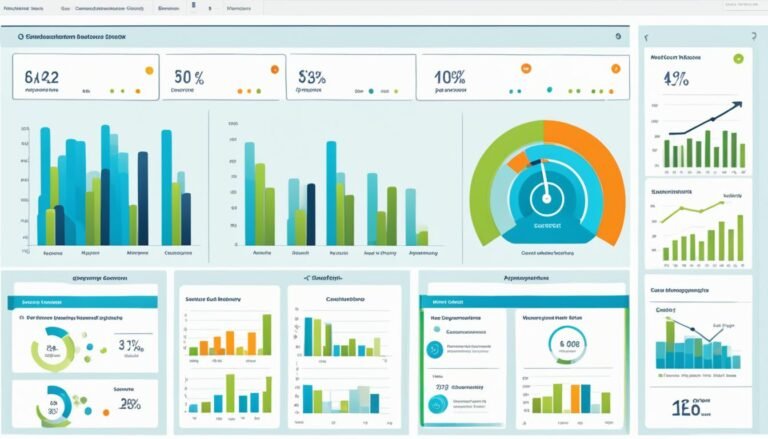What is agile management and why is it effective?
Did you know that using agile management can make projects 28% more successful? This approach has changed how projects, especially software ones, are done. It focuses on being flexible, working together, and listening to customers.
It works by dividing work into short cycles, known as sprints. During these sprints, the team improves its work constantly. This way, it can quickly adjust to new needs and bring value to the project sooner.
Key Takeaways:
- Agile management is a flexible and customer-centric methodology primarily used in software development.
- It emphasizes collaboration, adaptability, and continuous improvement through iterative development cycles.
- Organizations that adopt agile management methodologies are 28% more likely to complete their projects successfully.
- Agile management enables faster delivery of solutions, reduces waste, and increases focus on customer needs.
- However, it is important to carefully consider when and how to apply agile methodologies to ensure the best outcomes for each project.
Agile Project Management Principles
Agile project management is based on 12 key principles. These principles help in being customer-focused, adaptable, and effective. They ensure that both stakeholders and teams benefit.
- Customer satisfaction as the highest priority: Agile project management makes the customer’s needs its top concern. It aims to deliver value and achieve their satisfaction.
- Embracing changing environments: Agile sees change as normal and a chance to improve. It adapts throughout the project.
- Delivering working software frequently: Agile works in short phases to provide reliable software. This shows progress and yields real results regularly.
- Close collaboration between stakeholders and developers: Agile promotes open conversation and team effort. This synergy enhances project results.
- Motivation and support for optimal project outcomes: Agile offers support and motivation. It helps team members do their best to increase project success.
- Using face-to-face meetings for efficient communication: Agile pushes for in-person meetings. This improves communication, speeds up decisions, and builds stronger team bonds.
- Measuring progress by working software: Agile gauges success through functional software delivery. This approach provides clear signs of project advancement and helps in evaluation.
- Promoting sustainable development: Agile aims for a sustainable work rhythm. It cares about the team’s well-being and the project’s long-term success.
- Focusing on technical excellence and simplicity: Agile values technical quality and simplicity. It believes these are key to effective and manageable solutions.
- Harnessing self-organizing teams: Agile lets teams make their own choices and organize themselves. This trusts in their skills and their role in project success.
- Regularly reflecting on improving efficiency: Agile always looks for ways to get better. It promotes continuous learning and enhancements in how work is done.
- Ensuring a collaborative and adaptable approach: Agile welcomes being flexible and adaptable. It encourages teamwork, responding well to changes.
Adhering to Agile’s principles leads to more efficient projects, better communication, happier customers, and delivering valuable solutions.
Benefits of Agile Project Management
Agile project management brings lots of perks that can really boost a project’s success. It offers a way to work that’s both flexible and team-based. This helps get tasks done better, faster, and with less risk of failure.
Agile lets teams roll out solutions quickly. They do this by working in short bursts, or sprints. This means they can adapt and make things customers need faster, keeping up with the market.
Less waste is another big plus. Agile methods make sure to focus on what’s most important first. This smart use of resources leads to better handling of costs and team efforts.
Being nimble and open to change is key in agile. Teams can easily shift gears to meet new needs or customer feedback. It’s all about ongoing improvement to stay on track with business goals.
The method’s focus boosts success too. Breaking work into small pieces keeps everyone on target. This avoids wasting time and ensures better project outcomes.
Spotting and solving problems quickly is easier with agile’s constant checks. This means smoother projects and happier clients because of the high-quality results.
Agile also makes work more engaging and clear by pushing for teamwork and sharing info. Everyone involved works together, making better decisions and boosting the project’s overall success.
Its simple approach cuts down on paperwork and meetings that don’t add value. More time goes into the work that actually moves the project forward.
Empowering teams to manage their work boosts everyone’s focus and keeps things on track. This self-driven model results in better project management.
Thinking about the customer’s needs all along is a priority. This means the final products really hit the mark for the people using them, adding true value.
Agile encourages talking and working together a lot. This means getting regular feedback from users happens fast, helping the team steer the project in the right direction.
Benefits of Agile Project Management:
- More rapid deployment of solutions
- Reduction of waste through resource minimization
- Increased flexibility and adaptability to change
- Increased success through focused efforts
- Faster detection of issues and defects
- Optimization of development processes
- Lighter weight framework
- Optimal project control
- Increased focus on specific customer needs
- Promotion of increased collaboration and feedback frequency
These benefits are key to a project’s success, making teams more effective and keeping everyone happy from start to finish.
Agile Methodologies and Frameworks
In Agile, there are many methods and frameworks to pick based on what you need. They give different ways for teams to do Agile management. This lets teams choose what works best for them.
Let’s look at some well-known Agile methods and frameworks:
- Scrum: Scrum focuses on team work, how they organize themselves, and working in short bursts. It’s big on talking a lot and working together.
- Kanban: Kanban is a system using cards to help teams see their work and reduce backlog. It’s all about quick feedback and getting better all the time.
- Lean: Lean aims to cut down waste and get more done with what you have. It’s focused on making work better and delivering real value.
- Dynamic System Development Model (DSDM): DSDM gives a set way to include everyone and work together well. It’s about delivering on time and on budget, with a plan.
- Extreme Programming (XP): XP loves doing things as a team, keeping it simple, and always getting better. It aims for happy customers and top-notch software.
- Crystal: Crystal has many versions, each fit for a different project and team. It loves talking, often giving out parts of the work, and teamwork.
- Adaptive Software Development (ASD): ASD is all about changing if you need to and giving customers what they want. It means working in steps and staying open.
- Agile Unified Process (AUP): AUP mixes the Unified Process with Agile ways. It tries to keep things simple, manage risks, and work through short steps.
- Crystal Clear Methods: Crystal Clear is for little teams, keeping things easy, delivering often, and getting better all the time.
- Disciplined Agile Delivery: Disciplined Agile Delivery blends Agile and Lean for a big or small project. It bets on delivery little by little and never stopping with improvements.
- Feature-driven Development (FDD): FDD is about showing off working stuff bit by bit. It cares a lot about how things are designed and made.
- Scrumban: Scrumban mixes Scrum and Kanban for a mix that’s just right. It uses the best of both to suit different teams.
- Rapid Application Development (RAD): RAD is for putting out samples fast and making them better right away with what users say. Users are a big part of making it.
Agile methods can also work with traditional ways, like waterfall, to make a special mix for a project. What you pick depends on what the project needs, how the team likes to do things, and what the company can do.
Agile Project Management Roles and Team Composition
In Agile project management, team setup is key for success. Roles vary based on the method chosen. They help the team work well together for timely project completion.
Common Roles in Agile Project Management
Agile project management often includes three key roles:
- Scrum Master: The Scrum Master is key in running the Agile process. They make sure the team sticks to the Scrum rules and helps with any roadblocks. Their aim is to promote a teamwork-focused, efficient atmosphere. The Scrum Master guides the team to meet the project’s goals.
- Product Owner: The Product Owner connects stakeholders with the team. They keep the product backlog, a list of tasks and features, up to date. Working with stakeholders, the Product Owner sets and refines these tasks. Their work enhances the product’s value and quality.
- Development Team: The Development Team makes the software happen. It’s made up of diverse roles like developers, designers, and testers. They work together to meet the project’s requirements in each cycle.
These roles support good teamwork, communication, and project unity in Agile settings.
Agile Team Composition
Agile teams often work close by, promoting easy communication and shared effort. This is great for face-to-face communication and quick solutions. Yet, these days, with more people working from home, teams often rely on virtual tools. They use online methods to keep in touch and work together effectively.

This image above highlights the value of close-team work in Agile settings.
The team can include other roles like stakeholders or experts, as needed by the project.
| Role | Responsibilities |
|---|---|
| Scrum Master | Facilitates the Agile process Ensures team effectiveness Removes impediments |
| Product Owner | Maintains the product backlog Collaborates with stakeholders Prioritizes and refines requirements |
| Development Team | Delivers the working software Implements, tests, and integrates Collaborates cross-functionally |
This table shows who does what in Agile management. But, remember, Agile adapts well to different situations and needs.
By combining the right skills and working closely, Agile teams can produce great results in changing environments.
Agile Project Management Methodologies
Agile teams choose from various methods to fit their project needs. Scrum, Kanban, Lean, and Extreme Programming (XP) are four well-known Agile methods.
Scrum focuses on teams, self-driven work, and completing tasks in short, focused times. Teams adjust quickly to new needs and make work choices based on what customers want.
Kanban encourages ongoing communication and finding ways to work better. It uses a visual board to show tasks in progress. This helps teams find and fix problems in their workflow.
Lean is about being efficient by cutting out what’s not needed. It aims to give customers what they want by making processes smoother and faster.
Extreme Programming (XP) is big on teamwork, simple solutions, and always getting better. It uses fast development times, lots of talks between developers and users, and tests to ensure good software.
These methods lay out ways to run Agile projects smoothly. While they each have their own style, they all focus on working closely with customers and being flexible.
Using these methods, Agile teams can deliver successful projects. They keep up with what customers want, and they remain adaptable in their approach.
Example
“Our team uses Scrum for our jobs, and it’s been great. Working in cycles has helped us deliver software more often. This makes our clients happy because we can adjust quickly. Scrum really helps us work efficiently together.”
– John Smith, Agile Project Manager
| Methodology | Key Features |
|---|---|
| Scrum | Cross-functional teams, self-organization, short iterations (sprints) |
| Kanban | Visual feedback, real-time communication, workflow optimization |
| Lean | Reduction of waste, increased efficiency, value delivery |
| Extreme Programming (XP) | Collaboration, simplicity, continuous improvement, automated testing |
Pros and Cons of Agile Project Management
Agile project management is popular for its success in projects. But, it also has its benefits and drawbacks. Organizations need to think about these before choosing Agile.
Advantages of Agile Project Management
- Agile methods allow teams to always improve their work.
- It lets projects change as teams talk with everyone involved, making results better.
- Agile teams are ready for change. They adjust quickly to keep their projects on track.
- With Agile, problems can be found and solved early thanks to lots of feedback.
- Users play a big role throughout the project. Their feedback helps ensure the end product meets their needs.
- By working in small parts, Agile reduces the chance of wasting time on unneeded features.
Disadvantages of Agile Project Management
- Results can vary with Agile projects, depending on team skill, how well everyone agrees, and the project’s complexity.
- It’s tough to tell how much progress is made with Agile because it focuses on small, constant improvements.
- Because it needs a lot of talking and working together, Agile projects can be very time-consuming.
- Achieving Agile’s goals depends a lot on good talks and sharing. This can be hard with certain workplace cultures or when working from different locations.
- Without strong support from leaders, Agile projects might face difficulties.
Before choosing to go Agile, it’s important to look at both its good and bad sides. By doing so, organizations can choose wisely and enjoy Agile’s advantages to their fullest.
Example of a Pros and Cons Table for Agile Project Management
| Pros | Cons |
|---|---|
| Continuous improvement | Inconsistent results |
| Flexibility | Difficulties in measuring progress |
| Adaptability to change | Time constraints |
| Rapid detection of issues | Constant communication and collaboration |
| Increased collaboration with users | Lack of management support |
| Reduced waste |
How to Become an Agile Project Manager
To become an Agile project manager, follow these steps:
- Get a bachelor’s degree in project management or a related field. It could be in computer science. This will give you the basics you need to manage Agile projects well.
- Work in project management or software development. Experience in these fields helps you understand and apply Agile practices better.
- Think about getting a master’s degree. This can make you more skilled and show employers you are dedicated to learning.
- Get certifications in Agile project management. These show you’re qualified. IT organizations like PMI offer certifications. The PMI Agile Certified Practitioner and Certified ScrumMaster are popular.
- Keep learning about Agile trends. Stay updated with the latest practices through events, workshops, and societies. This helps you grow and perform better in your job.
By updating your skills and knowledge, you can be successful as an Agile project manager.
Quote:
“Becoming an Agile project manager needs education, experience, and certifications. Keep learning about Agile to be great in this dynamic field.” – Jane Smith, Certified Agile Project Manager
Agile Project Management vs. Waterfall
Agile and Waterfall project management differ in their core methods. Waterfall is known for its step-by-step approach, with clear goals from the start. Agile is all about being flexible, working closely with others, and improving as you go. It’s about being able to adjust the plan based on what you learn through the process.
Choosing between Agile and Waterfall depends on the project’s needs and the team’s style. If a project’s needs often change, Agile might be best. It lets you work closely with your customer and adjust as needed. But if everything is clear from the beginning, like the project’s goals and timeline, then Waterfall could work better.
Agile and Waterfall each have good and not-so-good sides. Agile lets you fix problems quickly and keeps you talking with the customer. This helps make sure the final product meets their needs. Waterfall’s detailed planning gives everyone clear goals and steps to follow. This can make big teams or projects with stable needs run smoother.
Deciding whether to go with Agile or Waterfall involves a lot of thinking. You have to look at how complex the project is, how many people are involved, and how much might change. Sometimes, blending parts of both methods can be the best option. This mix can fit the project’s unique needs.
In the end, choosing Agile or Waterfall is about what fits the project best. Agile is known for its adaptability, teamwork, and always getting better. Waterfall, on the other hand, is about following a clear plan and hitting set goals. Knowing these key differences helps in making the right choice for your project.
| Agile Project Management | Waterfall |
|---|---|
| Flexible and adaptable | Sequential and structured |
| Emphasizes collaboration and customer feedback | Requires detailed planning upfront |
| Allows for changes throughout the project | Follows a predetermined plan |
| Suitable for evolving requirements | Suitable for stable requirements |
| Quick identification and resolution of issues | Clear expectations and milestones |
Conclusion
Agile management is a great way to handle projects, especially in software and other areas. It focuses on being flexible, working together, adapting, and always getting better. This leads to better work, happier clients, and high-quality results. Frameworks like Scrum, Kanban, and Lean show the way in Agile project management.
Yet, each project’s unique needs and the challenges of going Agile are important to think about. Understanding Agile’s core principles and perks is key to its success. When companies use Agile well, they can succeed more and use their resources better to please customers.
In a nutshell, Agile management creates an environment for teams to change easily, work well together, and constantly add value. Adopting Agile’s ways helps companies do better in projects and make customers happier. Agile is proven to make work more efficient, bring people together, and produce top-notch work.
FAQ
What is agile management and why is it effective?
Agile management is a flexible approach, mainly used in making software. It focuses on quick deployment, reduced waste, and meeting customer needs well. This method works well because it allows fast changes, saving time and effort.
What are the agile project management principles?
The agile project management follows several key ideas. These include putting customer needs first, adapting to changes easily, and constant teamwork. It also values face-to-face talks, aims for steady project progress, and looks to make work life better.
What are the benefits of agile project management?
Agile project management brings many good things. It speeds up offering solutions, cuts useless work, and helps deal with changes. It also sharpens the focus on customer wants and boosts working together more often.
What are some commonly used agile methodologies and frameworks?
Many known methods and frameworks fall under the agile umbrella. For example, there’s Scrum for quick project cycles and Lean that aims to cut down on waste. Others include Kanban, XP, and Crystal for their unique ways of organizing work.
What are the roles and composition of an agile project management team?
In an agile setup, you’ll find key members like a Scrum Master, Product Owner, and Development Team. The Scrum Master leads the agile work and makes sure everything runs smoothly. The Product Owner keeps tabs on what needs to be done and talks to everyone involved. Lastly, the Development Team churns out the actual software.
What are some popular agile project management methodologies?
Scrum and Lean are quite popular in agile project management. Scrum focuses on small, dedicated teams and quick project phases. Lean, on the other hand, is all about cutting out anything that doesn’t add value.
What are the pros and cons of agile project management?
The good side of agile covers things like constant growth, flexibility, and quick-fixing of problems. However, it can be hard to keep track of how well things are going. It also needs everybody to keep talking and working closely all the time.
How can I become an agile project manager?
To become an agile project manager, start by getting a bachelor’s degree in a relevant area. Gain work experience and then think about a master’s degree in agile project management. Also, consider getting certified by groups like the Project Management Institute to show you really know your stuff.
What is the difference between agile project management and waterfall?
Agile and waterfall are two different ways to manage projects. Waterfall is more about following a set plan step by step. Agile, however, lets you make changes as you go and work more closely with customers. Both have their strengths, so it depends on what the project calls for.








